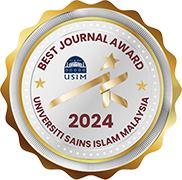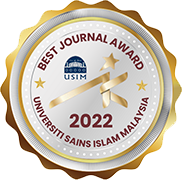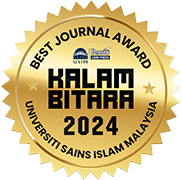GUARDIAN'S RESPONSIBILITY FOR THE WELFARE OF CHILDREN IN MARRIAGE: A STUDY ACCORDING TO ISLAMIC LAW
DOI:
https://doi.org/10.33102/mjsl.vol12no3.765Keywords:
Child’s marriage, child’s welfare guardianship, Islamic law, rights of childrenAbstract
In Islam, guardianship is a fundamental pillar of marriage, particularly in cases involving children, highlighting the guardian's critical role in ensuring the child's welfare is fully protected before the marriage is solemnised. This responsibility is essential in preventing potential child abuse arising from the guardian's failure to safeguard the child's rights adequately. This article seeks to elucidate the Islamic legal concept of guardianship in marriage and the guardian's duty to ensure the well-being of children born within the marital union. The analysis extends to key aspects of child welfare that require careful consideration before entering marriage. The research methodology follows a content analysis approach, thoroughly examining textual and contextual elements within Islamic legal sources, scholarly writings, and relevant documents. The research is based on two primary theoretical frameworks, namely Maqasid al-Shari’ah, which provides a comprehensive understanding of how guardianship aligns with the broader objectives of Shari’ah, and Fiqh, which offers a detailed exploration of specific legal rulings across various schools of thought. The findings highlight that, despite the guardian's inherent discretion in facilitating a marriage, Islamic law obliges the guardian to prioritise and take responsibility for the child's welfare. This obligation stems from the understanding that, by overseeing the marriage, the guardian is also accountable for protecting the child from harm throughout the marital period. This study contributes to the scholarly discourse on Islamic family law, providing insights into the theoretical foundations and practical implications of guardianship and child welfare within Islamic marriages.
Downloads
References
Abd. Rahman, M. S. (2007). Undang-Undang Keluarga Islam: Aturan perkahwinan: Suatu pendekatan berdasarkan Amalan semasa. Intel Multimedia and Publication.
Abdul Mutalib, M., Rahimah Saimin, Ghulam Khan, I. N., Abdul Ghafar, A., & Nik Saleh, N. S. S. (2024). Legal requirements of home-based childcare centres in malaysia; Are childcare providers aware?. Malaysian Journal of Syariah and Law, 12(2), 311–323. https://doi.org/10.33102/mjsl.vol12no2.517
Abdul Rahman, N. H., & Yasin, R. B. (2022). Children's rights to “Zero Hunger” and the execution challenges during the COVID-19 Crisis. Hasanuddin Law Review, 8(2), 139. https://doi.org/10.20956/halrev.v8i2.3684
Adawiyah, R., Mukhlisa, D., Yuliatin., & Ali Putra, D. (2022). The reconstruction of Aisyah’s marriage age as a resolution for child marriage practices phenomenon. Al-‘Adalah, 19(1), 69-98.
Al-Asfara’ni. (1998). Abu Awanah Ya’qub bin Ishak tahqiq Aiman bin Arif al-Dimshaqi. Musnad Abi Awanah. Darul Ma’rifah.
Al-Ayid, A. (1989). al-Mu’jam al-‘Arabi al-‘Asasi. Munazzomah al-‘Arabiyyah.
Al-Barri, Z. (1964). Ahkam al-Awlad fi al-Islam. Maktabah al-Arabiyah.
Al-Bugho. (2000). Mustafa. al-Fiqh al-Minhaji, Dar al-Qalam.
Al-Bustani, F. I. (1977). Munjid al-Tullab. Dar al-Masyriq.
Al-Haitami, A. I. H. (1938). Hawashi Tuhfatul Minhaj bi Sharh Minhaj. Maktabah Tijariah Kubra.
Al-Husaini, T. (2001). Kifayatu al-Ahyar fi Hilli Ghayatu al-Ikhtishar tahqiq Abdul Qadir al-Arnaut. Dar al-Basyair.
Alias, M. A. A., Mohd Jailani, M. R., Wan Ismail, W. A. F., & Baharuddin, A. S. (2024). The integration of five main goals of shariah in the production of science and technology for human well-being. AL-MAQASID: The International Journal of Maqasid Studies and Advanced Islamic Research, 5(1), 1–16. https://doi.org/10.55265/al-maqasid.v5i1.79
Al-Jaziri, ‘A. A. R. (1999) Kitab al-Fiqh ‘ala al-Madhahib al-Arba‘ah. Dar al-Manar.
Al-Kasaniy, A. H. (2000). Kitab bada’i‘ al-Sana‘ i fi Tartib al-Shara‘ iy. Darr Ihya’ al-Turath al-Arabiy.
Al-Khatib, S. A. (2002). Fiqh al-Tifl: Dirasah Muqaranah fi Dau’ al-Madhahib al- Fiqhiyyah al-Sab’ah. Mu’assasah al-‘Arif.
Al-Khin, M., Al-Bugha, M., & Al-Syarbiji, A. (1998). al-Fiqh al-Manhaji ‘Ala Madhahib al-Imam al-Syafi‘i. Dar al-Syamiyyah.
Al-Nawawi, A. Z. Y. S. (2000). Rawdah al-Talibin (Tahqiq: Adil Ahmad ‘Abd al-Mawjud. Dar al-Kutub al-Ilmiyyah.
Al-Nawawi, A. Z. Y. S. (2001). Majmu’ Syarh al-Muhazzab. Idarah al-Tiba’ah al-Munirah.
Al-Nawawi, A. Z. Y. S. (2022). Sahih Muslim bi Syarh al-Nawawi. Maktabah Al-Safa.
Al-Qurtubi, A. W. M. A. I. R. (1996). Bidayah al-Mujtahid wa Nihayah al-Muqtasid. Dar al-Turath al-Arabi.
Al-Sarakhshi. (1983). Kitab al-Mabsut, (Jil. 5) iv. 236; Fauzi, I., Ahkam al-Usrah fi al- Jahiliyyah wa al-Islam. Dar al-Kalimah.
Al-Suyutiy, A. (1998). Al-Ashbah wa al-Nazair fi Qawaid wa Furu’ fiqh al-Syafi’iyyah. Dar al-Kutub al-Ilmiah.
Al-Syafi’i. M. I. (1973). Al-Um. Maktabah al-Halabi.
Al-Syatibi. (n.d.) Al-Muwafaqat fi Ushul al-Ahkam. Dar al-Kutub al-Ilmiyyah.
Al-Syirazi, A. Y. (n.d.) al-Muhadzzab fi Fiqhi al-Imam al-Shafie’. Dar al-Kutub al-Ilmiah.
Al-Syirbini, A. K. (1994). Mughni al-Muhtaj ila Ma‘rifah Ma‘ani Alfaz al-Minhaj. Dar al-Kutub al-‘Alamiyyah.
Al-Tusi, N. A. D. A. A. R. S. S. (1987). Sharh Mukhtasir al-Raudhah. Muassasah al-Risalah.
Al-Zuhayli, W. (1985). Al-Fiqh al-Islami wa Adillatuh. Dar al-Fikr.
Atwah, A. A. A. (1993). Al-Madkhal ila as-Siyasah as-Syariyyah. Jami’ah al-Imam Muhammad bin Sa’ud al-Islamiyyah.
Barkah, Q., & Huzaimah, A. (2022). Abandonment of women's rights in child marriage: An Islamic law perspective. AL-IHKAM: Jurnal Ilmu Hukum, 17(2), 215-230. https://ejournal.iainmadura.ac.id/index.php/alihkam/article/view/6725
Bowden, J. J. (2013). Marriageable Age in Islam: A Study on Marriageable Age Laws and Reforms in Islamic Law. LUX, 2(1), 1–16. https://doi.org/10.5642/lux.201301.05
Catic, N. (2023). Islamic ethical considerations on medical decision-making in adolescence [Master's dissertation, University of Western Ontario]. Western Libraries. https://ir.lib.uwo.ca/etd/9675/
Darussamin, Z., Armansyah., & Zikri, A. (2023). The urgency of maturity to get married and its relevance to family life goals. Al-Istinbat: Jurnal Hukum Islam, 8(1), 215-236.
Dewan Bahasa dan Pustaka. (2015). Kamus dewan edisi keempat. Dewan Bahasa dan Pustaka.
Disemadi, H. S., Al-Fatih, S., & Yusro, M. A. (2020). Indonesian children protection against commercial sexual exploitation through siri marriage practices in maqashid al-shariah perspective. Brawijaya Law Journal, 7(2), 195–212. https://doi.org/10.21776/ub.blj.2020.007.02.04
Hashim, H. Ghulam Khan, I. N., A. Shukor, H., & Yusof, N. (2019). Perkahwinan bawah umur menurut perspektif undang-undang jenayah Islam dan undang-undang sivil di Malaysia. In Prosiding 5th Muzakarah Fiqh & International Fiqh Conference-MFIFC 2019. (pp. 100-114).
Hikmat, R. (2017). A study on child marriage in Jordan. Research Report Higher Population Council (HPC).
Ibn Manzur, M. I. M. (2005). Lisan al-'Arab. Dar Sadir.
Ibn Qudamah, A. M. A. A. M. (1999). Al-Mughni. Dar ‘Alam al-Kutub.
Ibrahim, B. (1997). Pemantapan sistem kekeluargaan. Darul Nu’man.
Jafari, M. (2014). Signs of puberty in Islamic jurisprudence. Journal of Life Science and Biomedicine, 4(2), 112–118.
Jalil, H. A., & Wirnanda, T. (2020). Wali nikah fasik (Studi perbandingan mazhab hanafi dan mazhab syafi’i). Media Syari’ah, 22(1), 82-92. https://doi.org/10.22373/jms.v22i1.6533
Judith E. T. (1998). In the house of Law: Gender and Islamic law in Ottoman Syria and Palestine. University of California Press.
Kasdi, A. (2014). Maqasyid syari’ah perspektif pemikiran Imam Syatibi dalam Kitab Al-Muwafaqat. Jurnal Pemikiran Hukum dan Hukum Islam, 5(1), 46-63.
Kato, M. (2017). “Women of Egypt. cairo review of global affairs”. Thecairoreview. https://www.thecairoreview.com/wp-content/uploads/2017/01/cr24-kato.pdf
Khallaf, A. W. (1988). As-Siyasah as-Syariyyah fi al-Syu’un al-Dusturiyyah wa all-Kharajiyyah wa al-Maliyah. Dar al-Qalam.
M. Nour, N. (2009). Child marriage: A silent health and human rights issue. Reviews in Obstetrics and Gynecology, 2 (1), 51–56.
Malek, M. A. G. A., Samuri, M. A. A., & Alias, M. N. (2023). Child marriage in Malaysia: Reforming law through the siyasa al-shar’iyya framework. Samarah: Jurnal Hukum Keluarga dan Hukum Islam, 7(1), 58-83.
Mohd, A., & Kadir, N. A. (2020). The theory of compulsion (ijbar) in marriage under Islamic law: Incorporation of the Hanafis view on compulsory consent in marriage under the Islamic Family Law (Federal Territories) Act 1984. Advances in Social Science, Education and Humanities Research, 413, 51-55. https://doi.org/10.2991/assehr.k.200306.180
Mubarak, F., & Januddin, J. (2022). “Fair” status of marriage wali according to Shafi'i Mazhab and Hanafi Mazhab. Al Mashaadir: Jurnal Ilmu, 12(1), 45-56.
Noor, Z. (2013). Perkahwinan kanak-kanak dan tahap minima umur perkahwinan dalam undang-undang keluarga Islam. Jurnal Syariah, 21(2),165-190.
Rohmat (2011). Kedudukan wali dalam pernikahan: Studi pemikiran Syâfi’îyah, Hanafiyah, dan praktiknya di Indonesia. Al-‘Adalah Vol. X, No. 2 Juli.
Sabiq, A. S. (1998). Fiqh al-Sunnah. Kaherah: Dar al-Fath li-al-`Ilam al-`Arabi.
Sujiman, M. S. & Mohamad, A. B. (2006). Fikah kekeluargaan. Kuala Lumpur: Universiti Islam Antarabangsa Malaysia.
Syed Husin, S. N. M. B., & Tengku Muda, T. F. M. (2011). Konflik antara hak wali mujbir di bawah hukum syarak dan peruntukan had umur minimum perkahwinan. Jurnal Islam Dan Masyarakat Kontemporari, 5, 7-16.
Tahir, T. (2020). The concept of maslahah according to Imam Al-Ghazali. Jurnal Al-Dustur: Journal of Politic and Islamic Law, 3(1), 22–29. https://doi.org/10.30863/jad.v3i1.642
Usman, A. H., Wazir, R., Mohd Norzi, N., & Mohd. Salleh, N. (2019). Pedophilia in quranic perspective: A thematic analysis, nóesis. Revista de Ciencias Sociales y Humanidades 4(18), 439-444.
Wan Ismail, W. A. F., Mamat, Z., Abdul Mutalib, L., Baharuddin, A. S., Alias, M. A. A., & Syed Husin, S. N. (2022). Perwalian dan isu berkaitan dengannya menurut syarak dan perundangan Islam di Malaysia. In the proceeding of International Prophetic Conference (SWAN) FPQS USIM, (pp. 1–13). https://swanfpqs.usim.edu.my/index.php/conference/article/view/5
Zahrah, A. (1957). al-Ahwal al-Syahsiyah. Dâr al-Fikr al-‘Arabi.
Zakiah, Z. (2019). The fundamental elements of requirements and conditions in convicting ‘sariqah’ and its punishment according to the Syariah penal code order, 2013. Journal of Islamic, Social, Economics and Development (JISED), 2(27), 26–38.
Zaydan, A. K. (1993). Al-Mufassal fi Ahkam al-Mar’ah wa al-Bait al-Muslim fi as-Syari’ah al- Islamiyyah. Muassasah al-Risalah.
Downloads
Published
Issue
Section
Categories
License
Copyright (c) 2024 Redwan Yasin, Nurul Hidayat Abdul Rahman , Sayuti Ab. Ghani, Mohamed Belal

This work is licensed under a Creative Commons Attribution-NonCommercial 4.0 International License.














































